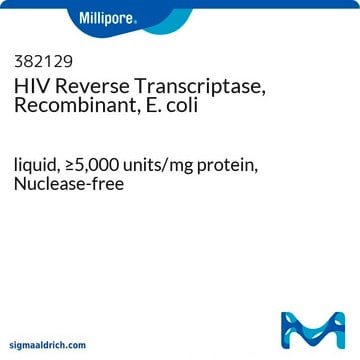추천 제품
생물학적 소스
Porcine intestinal mucosa
Quality Level
재조합
expressed in E. coli
양식
liquid
사용
sufficient for 200 reactions
sufficient for 250 reactions
특징
dNTPs included: no
hotstart: no
농도
200 units/μL
기술
RT-PCR: suitable
색상
colorless
입력
purified RNA
배송 상태
wet ice
저장 온도
−20°C
일반 설명
애플리케이션
- for the preparation of cDNA libraries or for first strand cDNA synthesis
- for use in a 2-step RT-PCR assay
- in quantitative realtime-polymerase chain reaction (RT-qPCR)
- in reverse transcription
특징 및 장점
- Thermostable reverse transcriptase active at 37 °C.
- Can be used to generate first strand cDNA of up to 7 kb.
포장
단위 정의
제조 메모
법적 정보
신호어
Danger
유해 및 위험 성명서
예방조치 성명서
Hazard Classifications
Resp. Sens. 1
Storage Class Code
12 - Non Combustible Liquids
WGK
WGK 3
Flash Point (°F)
Not applicable
Flash Point (°C)
Not applicable
개인 보호 장비
Eyeshields, Gloves, multi-purpose combination respirator cartridge (US)
이미 열람한 고객
문서
The introduction of small interfering RNAs (siRNAs) into cultured cells provides a fast and efficient means of knocking down gene expression and has allowed siRNAs to quickly become a ubiquitous tool in molecular biology.
Introduction of small interfering RNAs (siRNAs) into cultured cells provides a fast and efficient means of knocking down gene expression and has allowed siRNAs to quickly become a ubiquitous tool in molecular biology.
관련 콘텐츠
RT-qPCR, or quantitative reverse transcription PCR, combines the effects of reverse transcription and quantitative PCR or real-time PCR to amplify and detect specific targets. RT-qPCR has a variety of applications including quantifying gene expression levels, validating RNA interference (RNAi), and detecting pathogens such as viruses.
자사의 과학자팀은 생명 과학, 재료 과학, 화학 합성, 크로마토그래피, 분석 및 기타 많은 영역을 포함한 모든 과학 분야에 경험이 있습니다..
고객지원팀으로 연락바랍니다.









